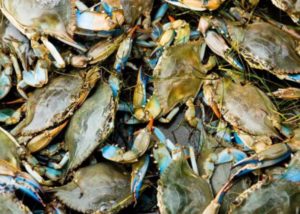A new report indicates water quality in the Chesapeake Bay is at its healthiest levels in 30 years.
Blue crabs and striped bass, which support commercial and recreational fisheries, and anchovies, the foundation of its food chain — earned top scores in a report card released Friday. Bright green underwater grasses — which help protect young fish before they venture into the Atlantic Ocean — are now thriving, even in some places where such vegetation had disappeared.

Blue Crabs (Photo Chesapeake Bay Program)
The eco-health report card issued by the University of Maryland’s Center for Environmental Studies grades bay health overall as a C, or moderate.
“While we can celebrate progress being made in the restoration of Chesapeake Bay, we can’t take our foot off of the accelerator,” Peter Goodwin, president of the environmental science center, said in a statement Friday. “It is critically important that we continue to invest in science and monitoring to improve management actions which ensure that the bay continues on its path to recovery.”
The report gauges bay health in several regions, from the upper bay to the lower eastern shore section, as well as in several regions where rivers enter the bay. Results are based on key indicators, including levels of pollutants like phosphorus and nitrogen.
“We all need to continue working in a bipartisan way … to support the science and good conservation practices,” Benjamin H. Grumbles, Maryland’s environment secretary, said at the report card announcement. “We need the EPA to keep everyone’s feet to the fire.”
Leave a Reply